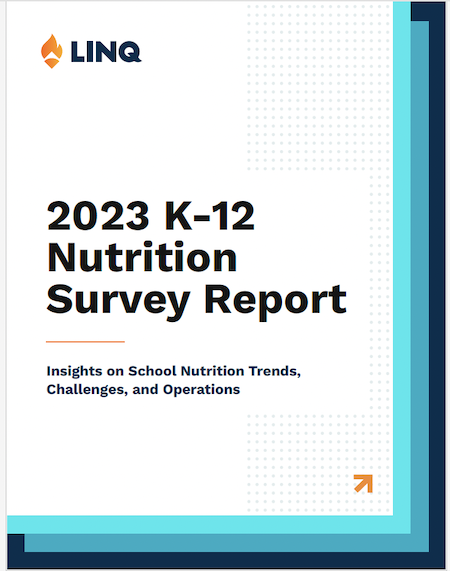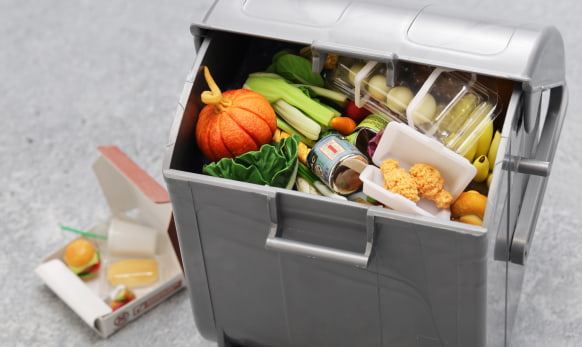Nutrition leaders and their staff work tirelessly, and the proof of those efforts is in the numbers. Each year, 30 million children are fed through nearly 100,000 schools in the U.S. million schools, adding up to an astonishing 4.9 billion lunches. That’s a lot of lunches—and when you consider recent reports that schools are where kids are getting their healthiest meals of the day, it’s clear how important school nutrition programs are to the students they serve.
The downside of the high volume? Lots of food served in K‑12 cafeterias creates a lot of food waste as well.
According to the USDA, up to 40% of the food supply in the United States is thrown away. On the list of food waste contributors, K‑12 schools fall far below restaurants and grocery stores. And yet, 530,000 tons of food (excluding milk)—roughly $1.7 billion according to a 2019 report—ends up in the trash every year.
Running a school nutrition program is a major balancing act. Every day, you serve hundreds of students in less than half an hour while pushing healthier options and following regulations and keeping budget in mind, all to turn around the lunchroom and do it again.
K‑12 students can be picky, messy, and just plain wasteful. All things considered, it’s easy to see why it’s difficult to make 100% perfect use of inventory.
The benefits of reducing food waste in school lunchrooms are well known, including:
- Saved costs on inventory that isn’t selling
- Uneaten foods can be re-allocated to those in need
- Having a greener lunchroom helps the environment
But what can you do to effectively cut down on the amount of uneaten food in your cafeteria? The good news is there are a variety of ways you and your team can reduce waste, make better use of your inventory, and even do some good for your community.
How to Reduce Food Waste in Your K‑12 Cafeteria
Read on for simple, actionable ways you can cut down on food waste in your K‑12 cafeteria:
Regularly engage with students and staff for input.
A simple conversation with students and staff can tell you a lot about what’s going to waste and why. In one EdWeek survey, students and parents expressed concerns that the short window allotted for lunch—as little as 20 minutes—isn’t enough time to finish eating. One study shows that by extending lunch by a mere five minutes led to a 13% decrease in entrée waste, 12% decrease in vegetable waste, and 10% decrease in milk waste.
If extending meal times is not infeasible due to current scheduling, consider small changes to your meal service or meal preparation that may drive higher consumption. For example, one school found that slicing apples led to 60% higher consumption than serving them whole.
If your district is unable to extend lunch periods, consider ways that your nutrition department can help students move through the lunch line quicker. Maybe the POS needs to be configured in a way that expedites checkout, or consider adding a pre-ordering option. Evaluate your Front of House software to work with you and help students spend more time at the cafeteria table instead of in line.
Small takeaways like these can go a long way toward your efforts in reducing food waste in your K‑12 cafeteria.
K-12 nutrition technology can help, especially an integrated FOH and BOH system
You’re already using nutrition technology to power your lunchroom. Use it to determine which items are unpopular. Kale chips might have seemed like a good idea, but your POS system might say differently. Watch your inventory like a hawk and plan menus based on your current stock. Get creative with how you use items with the Power of Three rule. If an item cannot be used in three days or in three ways, it should not be used in your food service. Item management can help your staff determine how to use an item in different amounts whether it’s a full serving or simply an ingredient.
A fully integrated FOH and BOH system like LINQ Nutrition takes all the guesswork out of smarter inventory management for you. BOH modules like Production Records and Inventory update in real time as items are sold or used. Not only does this eliminate tedious hours spent updating spreadsheets, but it also automates inventory to improve accuracy and enables. The system can then deliver purchasing forecasts to ensure your kitchens get the supplies and ingredients they need without overspending on excess inventory. Accurate, real-time data also helps you clearly identify top-selling items and seasonal or weekly trends.
Once you know which menu and a la carte items are most loved by students and staff, you can ramp up participation through promotion. You can easily generate excitement about what you’re serving by:
- Posting your menu on the district’s website
- Using digital menu boards around the school
- Promoting on the social media profiles for your school or your cafeteria
- Sending email newsletters to families so your menu is always top-of-mind
Implement Offer vs. Serve Beyond the High School.
While it may be required to conduct offer vs. serve at the high school level, did you know you can also implement at lower grade levels? If you haven’t already, consider switching to an offer vs. serve model to reduce unnecessary food waste.
Operating offer vs. serve can help reduce food waste in that children are only selecting foods they want to eat versus those they have to eat. In one research study, it was uncovered that 13 gallons of milk were thrown away in one day. And yet, the government has not mandated that students must take a carton of milk with their lunch since 1982.
Allowing students to choose items like milk or fruit could lead to a lot less inventory being thrown in the trash.
Create a share table.
Adding a share table is a fantastic way to reduce food waste in K‑12 cafeterias. A share table is a place in your cafeteria to put extra, uneaten food items that are then offered to students or donated.
And it’s easy to see why they’re so popular in K‑12 cafeterias: they cost very little to set up and help to feed those in need. On top of that, share tables help reduce food waste. While share tables can be very easy to implement, fewer than 1% of public schools have one.
Interested in planning a share table of your own? Check out resources from the USDA on how to implement a share table in your program. Also be sure to check with your state agency to ensure you are compliant with any additional state requirements.
Donate uneaten food to a good cause.
You’ve adjusted your inventory to your students’ tastes, planned meals accordingly, and offered uneaten foods to other students. Now, what do you do with the leftovers? Donate, donate, donate!
Due to the fear of liability, many organizations throw perfectly good food away instead of donating it. In addition, any food that’s left over at the end of a food service on a share table cannot be used again in the food service. However, food directors have been protected under the Bill Emerson Good Samaritan Act since 1996. Resources on Food Recovery Programs offer excellent guidelines and tips for starting a program for your school or district.
If it must go to waste, consider composting.
On average, a school of 200 students generates 75 pounds of compostable each week. Yet fewer than 5% of schools compost, despite its being a great option. Do you have a school garden that could benefit from compost? Or maybe there’s a local farm you can donate to?
You’ll need to educate your staff and student body which items to trash, which items to recycle, and which items are for compost. Check out this resource from the Cornell Waste Management Institute for more information on how to get your school’s compost program started.
Now’s the time to reduce waste in your K‑12 cafeteria.
More than 9 million children in the U.S. are food insecure. With statistics like this as our reality, reallocating uneaten food to those in need can be an important contribution in bringing those numbers down. Putting any (or all!) of these ideas into action can at least reduce the massive volume of waste that builds up each year. Utilizing nutrition technology, food recovery or donation programs, and ideas from your students and staff, your efforts can make an impact on your school, district, community, and the environment.
Check out our K-12 Nutrition Survey Report for more insights on school nutrition trends, challenges, and operations.







